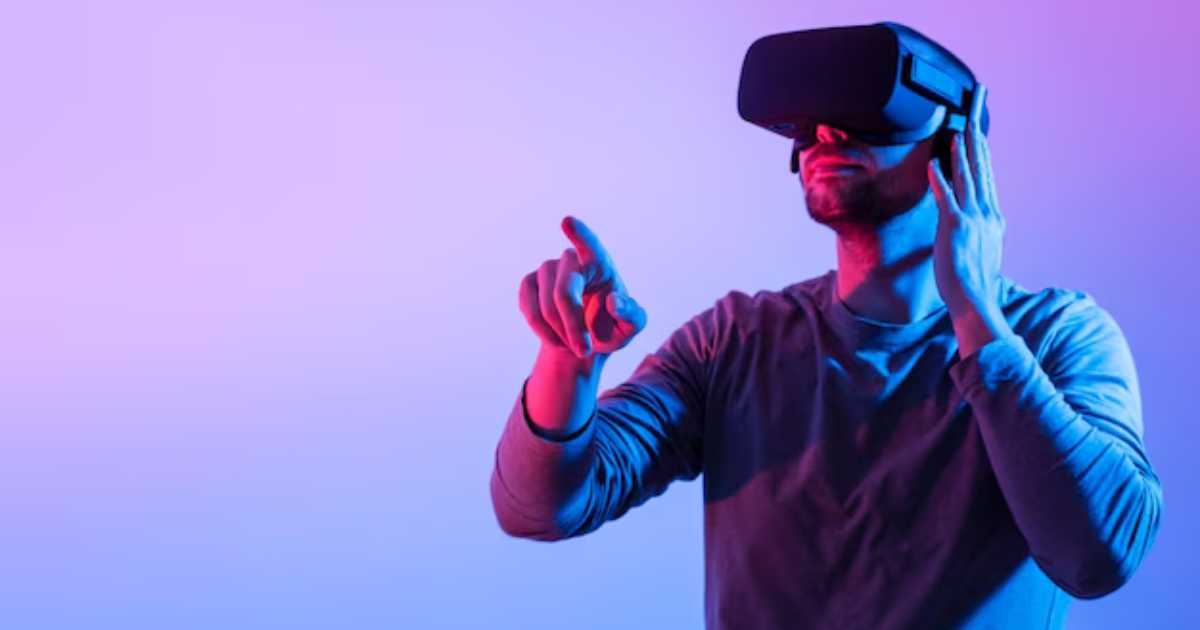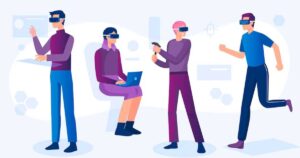The use of augmented reality (AR) has had a huge effect on how businesses connect with their customers. Marketers now have more possibilities for developing attractive and engaging experiences because of augmented the reality of (AR) potential to display virtual material in the real world. This in-depth article will look at 10 strategies for using augmented reality marketing to grow your business.
Introduction
Traditional marketing strategies are unable to capture viewers in the modern digital era. Customers are looking for unusual and engaging experiences that go above and beyond the norm. This is where marketing using augmented reality is useful. AR helps businesses to create unique and personalized experiences that have an ongoing effect on their target audience by combining the virtual and actual worlds.
What is Augmented Reality Marketing?
Augmented reality marketing refers to the use of AR technology to promote products, services, or brands. It involves overlaying digital content, such as 3D models, animations, or interactive elements, onto the real-world environment through the use of mobile devices, smart glasses, or other AR-enabled devices. This innovative approach allows businesses to deliver immersive and interactive experiences to their customers, blurring the line between the physical and digital realms.
Join Now and Get The Best augmented reality Services
Benefits of Augmented Reality Marketing
- Enhances customer engagement
- Increases brand awareness
- Improves customer experience
- Drives sales and conversions
#Enhances Customer Engagement
One of the key advantages of augmented reality marketing is its ability to captivate and engage customers. By offering interactive and immersive experiences, AR campaigns can grab the attention of consumers and keep them actively involved. Whether it’s trying on virtual clothing, visualizing furniture in their homes, or exploring virtual showrooms, AR creates a sense of excitement and involvement, fostering deeper connections between brands and their customers.
#Increases Brand Awareness
Augmented reality marketing offers unique opportunities to boost brand awareness. When brands deliver memorable AR experiences, customers are more likely to share their encounters with friends and family, increasing the reach and visibility of the brand. AR campaigns have the potential to go viral, generating buzz and creating a positive brand image in the minds of consumers.
#Improves Customer Experience
AR enhances the overall customer experience by providing personalized and interactive encounters. Customers can explore products or services in a virtual environment, visualize how they would fit into their lives, and make informed purchase decisions. By enabling customers to virtually try before they buy, AR eliminates uncertainties and reduces the risk of buyer’s remorse, leading to higher customer satisfaction.
#Drives Sales and Conversions
The immersive and interactive nature of augmented reality marketing has a direct impact on sales and conversions. When customers can visualize products or experiences in their own environment, they develop a stronger connection and are more likely to convert. AR-driven campaigns have been shown to increase conversion rates, reduce product returns, and drive higher sales revenue for businesses.
Tips for Implementing Augmented Reality Marketing
1. Understand your target audience
Before diving into augmented reality marketing, it’s essential to understand your target audience and their preferences. Conduct market research to identify the demographics, interests, and behaviors of your potential customers. This knowledge will help you tailor your AR campaigns to resonate with your target audience effectively.
2. Set clear goals and objectives
Define clear goals and objectives for your augmented reality marketing initiatives. Whether it’s increasing brand awareness, driving website traffic, or boosting sales, having specific goals in mind will guide your strategy and enable you to measure the success of your campaigns.
3. Choose the right AR platform
Selecting the right AR platform is crucial for the success of your campaigns. Consider factors such as ease of use, compatibility with your target devices, and available features. Popular AR platforms include ARKit for iOS, ARCore for Android, and Spark AR for Facebook and Instagram.
4. Create interactive and engaging experiences
You may keep the audience’s interest by creating interesting settings. Include 3D models, animations, and entertainment aspects in your augmented reality commercials to make them more visually appealing and engaging for consumers. It is crucial to motivate social media users to sign up and publish their own stories.
5. Incorporate AR into your marketing strategy
Augmented reality should not be treated as a standalone initiative. Integrate AR into your overall marketing strategy to create a cohesive brand experience across multiple channels. Combine AR with social media, influencer marketing, or email campaigns to amplify its impact.
6. Leverage user-generated content
Encourage users to create and share their AR experiences with your products or services. User-generated content not only increases brand authenticity but also extends the reach of your AR campaigns. Consider hosting contests or offering incentives to motivate users to generate content.
7. Integrate social media and AR
Social media platforms provide an excellent opportunity to showcase your augmented reality marketing campaigns. Leverage features like Instagram filters, Facebook’s Spark AR, or Snapchat lenses to engage your audience on popular social channels.
8. Optimize for mobile devices
Given the widespread use of smartphones, ensure that your AR experiences are optimized for mobile devices. This will maximize accessibility and allow users to engage with your campaigns on the go. Optimize loading times and ensure compatibility with different screen sizes and resolutions.
9. Measure and analyze your AR campaigns
Use analytics and tracking software to monitor the success of your augmented reality marketing activities. Keep track of data like conversion rates, ROI, and engagement rates. Utilize this information to better upcoming campaigns and your strategy.
10. Stay updated with AR trends and technologies
Augmented reality is a rapidly evolving field, with new technologies and trends emerging regularly. Stay updated with the latest developments and innovations in AR to ensure your campaigns remain fresh and captivating. Experiment with new features and functionalities to stand out from the competition.
5. Case Studies: Successful Augmented Reality Marketing Campaigns
- IKEA Place: Virtual Furniture Shopping: IKEA, the Swedish furniture retailer, launched the IKEA Place app, which utilizes augmented reality to help customers visualize how furniture would look in their homes. By using the app, users can select furniture pieces from the IKEA catalog and place them virtually in their desired space. This AR marketing campaign increased customer engagement, reduced the uncertainty of online furniture shopping, and led to higher conversion rates.
- Pokémon Go: Gamifying Real-World Exploration: Pokémon Go took the world by storm when it was released in 2016. This location-based augmented reality game encouraged players to explore their surroundings in search of virtual Pokémon characters. Businesses quickly recognized the marketing potential and started leveraging the game by offering discounts and promotions for players who visited their locations. The campaign resulted in increased foot traffic, brand exposure, and customer acquisition for many businesses.
- Snapchat’s AR Lenses: Interactive Brand Experiences: Snapchat’s AR lenses have provided brands with a powerful marketing tool. Companies can create sponsored lenses that allow users to overlay branded elements onto their selfies or the world around them. For example, Taco Bell launched a lens that turned users’ faces into tacos, generating millions of views and user-generated content. This interactive and engaging AR marketing campaign increased brand awareness and customer interaction with the brand.
6. Challenges and Limitations of Augmented Reality Marketing
While augmented reality marketing offers numerous benefits, it also comes with its fair share of challenges and limitations. Some of the common challenges include:
- Adoption and Accessibility: Although augmented reality technology has advanced rapidly, not all consumers have access to AR-enabled devices or applications. This limits the reach and effectiveness of AR marketing Campaigns, as they may only target a subset of the Target audience.
- Development and Implementation Costs: Creating high-quality and engaging augmented reality experiences can be costly and time-consuming. From developing custom AR applications to designing interactive content, the upfront investment required for AR marketing campaigns can be a barrier for some businesses.
- User Experience and Technical Limitations: AR experiences need to be seamless, intuitive, and user-friendly to be successful. However, technical limitations such as tracking accuracy, device compatibility, and processing power can impact the user experience. Balancing technical capabilities with user expectations is a constant challenge for AR marketers.
- Limited Analytics and Metrics: Compared to traditional digital marketing channels, measuring the success of augmented reality marketing campaigns can be more challenging. There is a lack of standardized metrics and analytics tools specifically tailored for AR. Marketers must find creative ways to track engagement, conversions, and ROI to evaluate the effectiveness of their campaigns.
7. Augmented Reality Examples | The Future of Augmented Reality Marketing:
The Future of Augmented Reality Marketing holds exciting possibilities for Businesses and consumers alike. Here are some key Trends to watch:
- Advancements in AR Hardware: As AR hardware continues to evolve, with innovations such as smart glasses and contact lenses, the accessibility and adoption of AR technology are expected to increase. This will open up new opportunities for marketers to deliver immersive AR experiences directly to consumers’ eyes.
- Integration with Artificial Intelligence: The combination of Augmented Reality and artificial intelligence (AI) will enable more personalized and Context-aware experiences. AI algorithms can analyze user preferences and behaviors to deliver tailored AR content, enhancing customer engagement and satisfaction.
- Augmented Reality in E-commerce and Retail: AR has the potential to transform the e-commerce landscape by allowing customers to virtually try on clothing, visualize products in their homes, preview cosmetic enhancements, preview furniture in their homes, or see how certain products would look in different environments. This will bridge the gap between online and offline shopping experiences, leading to higher conversion rates and reduced returns.
- AR as a Sales Enablement Tool: Augmented reality can empower sales teams by providing interactive and immersive product demonstrations. Sales professionals can use AR to showcase products in real-time, highlight features, and overcome buyer hesitation, ultimately driving faster and more informed purchasing decisions.
- Augmented Reality in Education and Training: AR can revolutionize the education and training sectors by offering interactive and immersive Learning experiences. From Virtual field trips to hands-on simulations, AR can enhance Engagement and retention, making learning more engaging and effective.
- Architecture and construction: AR can help architects and builders visualize designs in real-world settings. They can overlay digital models onto physical spaces, enabling them to assess design concepts, make modifications, and communicate ideas more effectively.
- Tourism and travel: AR can enhance the travel experience by providing virtual tour guides, historical information, and interactive maps. Travelers can use AR apps to explore landmarks, access translations, or receive personalized recommendations based on their location.
- Healthcare: AR technology can assist healthcare professionals in various ways. Surgeons can use AR overlays during procedures to view real-time patient data or navigate complex anatomical structures. AR can also aid in medical training, allowing students to practice procedures in a virtual environment.
- Manufacturing and maintenance: AR can improve efficiency and accuracy in manufacturing processes. It can provide real-time instructions to workers, highlight potential issues, or assist in quality control. AR can also guide technicians during equipment maintenance and repair tasks.
- Tourism and travel: AR can enhance the travel experience by providing virtual tour guides, historical information, and interactive maps. Travelers can use AR apps to explore landmarks, access translations, or receive personalized recommendations based on their location.
- Tourism and travel: AR can enhance the travel experience by providing virtual tour guides, historical information, and interactive maps. Travelers can use AR apps to explore landmarks, access translations, or receive personalized recommendations based on their location.
These are just a few examples of how augmented reality can be applied across different categories. The technology continues to evolve, and new applications are being discovered as it becomes more accessible and integrated into various industries. The future of augmented reality marketing is bright, with ongoing technological advancements and increasing consumer adoption. As businesses adapt and leverage AR to create unique and memorable experiences, it will continue to reshape the way brands connect with their target audience.
(AR) Augmented reality tools are software applications or devices that enhance the real world by overlaying digital content onto it. These tools leverage the capabilities of cameras, sensors, and displays to blend virtual elements with the user’s environment in real time. Here are some popular AR tools:
- ARKit: Developed by Apple, ARKit is a framework that enables developers to create AR experiences for iOS devices. It provides features like motion tracking, scene understanding, and light estimation.
- ARCore: Developed by Google, ARCore is a platform for building AR applications on Android devices. It offers similar functionalities to ARKit, including motion tracking, environmental understanding, and light estimation.
- Vuforia: Vuforia is an AR development platform that allows developers to create augmented reality experiences across various devices. It provides features like image recognition, object tracking, and augmented reality content management.
- Unity: Unity is a popular game development engine that also offers robust AR capabilities. It provides a comprehensive development environment for creating AR applications and supports platforms like iOS, Android, and Microsoft HoloLens.
- Spark AR Studio: Spark AR Studio is a tool developed by Facebook that allows users to create AR effects for platforms like Instagram and Facebook. It provides an intuitive interface for designing and building AR experiences.
- Microsoft Mixed Reality Toolkit: The Microsoft Mixed Reality Toolkit (MRTK) is a collection of scripts and components that aids in the development of AR and mixed reality applications. It supports various platforms, including Windows Mixed Reality, HoloLens, and Azure Kinect.
- Snapchat Lens Studio: Lens Studio is a tool by Snapchat that enables users to create and publish AR lenses for the Snapchat app. It provides a wide range of interactive AR features and effects.
These are just a few examples of the many AR tools available today. The field of augmented reality is continuously evolving, and new tools and platforms are being developed to push the boundaries of AR experiences further.
8. Conclusion
Augmented reality marketing presents an exciting opportunity for businesses to create unique and immersive experiences that captivate their audience. By following the ten tips outlined in this ultimate guide, you can harness the power of AR to enhance customer engagement, increase brand awareness, improve customer experiences, and drive sales and conversions. Embrace augmented reality marketing today and unlock the full potential of this transformative technology.
FAQs
Q: How does augmented reality marketing work?
A: Augmented Reality Marketing works by overlaying virtual Content in the real-world environment using AR technology. By leveraging mobile devices or AR-enabled devices, users can interact with digital elements that appear in their Physical surroundings, creating immersive and Engaging experiences.
Q: Is augmented reality marketing suitable for all industries?
A: While augmented reality marketing has proven successful across various industries, its suitability Depends on the specific goals, target audience, and nature of the products or services. Industries such as retail, e-commerce, real estate, tourism, and education have seen significant benefits from implementing AR marketing strategies.
Q: How much does it cost to implement augmented reality marketing?
A: The cost of implementing augmented reality marketing can vary Depending on factors such as the complexity of the AR experiences, the chosen AR platform, and the extent of customization required. It’s recommended to consult with AR experts or Agencies to get a tailored cost estimate based on your specific requirements.
Q: Can augmented reality marketing be used for B2B businesses?
A: Yes, augmented reality marketing can be utilized by B2B businesses to showcase products, provide virtual demonstrations, or create interactive training experiences. AR can enhance the communication and understanding between businesses and their clients, ultimately driving engagement and sales.
Q: What are some common mistakes to avoid in augmented reality marketing?
A: Some common mistakes to avoid in Augmented reality marketing include neglecting proper user testing and optimization, creating experiences without a clear purpose or call to action, overcomplicating the AR content, and failing to align the AR experiences with the overall brand messaging and identity.
Also, Read- 10 Ways Virtual Reality Marketing Enhances Customer Engagement in the Digital Age






